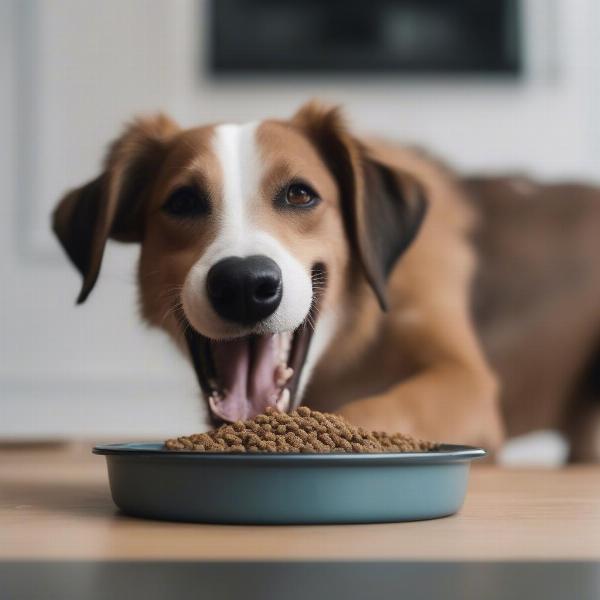Raw dog food, often referred to as the “BARF” diet (Biologically Appropriate Raw Food or Bones and Raw Food), has gained significant popularity among dog owners seeking a more natural approach to canine nutrition. This diet typically consists of uncooked muscle and organ meats, bones, fruits, and vegetables, mirroring the ancestral diet of canines. While raw feeding can offer potential benefits, it’s essential to understand the intricacies involved to ensure your dog’s health and safety. This comprehensive guide will explore the benefits, risks, and practical considerations of feeding your dog a raw diet.
Understanding the Raw Dog Food Diet
The philosophy behind raw feeding is to provide dogs with a diet that mimics what their wild ancestors consumed. Proponents believe this approach can lead to improved digestion, healthier skin and coat, increased energy levels, and better dental health. While some of these claims have anecdotal support, scientific evidence is still limited and more research is needed to definitively confirm these benefits.
Benefits and Risks of a Raw Dog Food Diet
Potential Benefits
- Improved Digestion: Some dogs experience better digestion on a raw diet due to the absence of processed ingredients and fillers found in commercial kibble.
- Healthier Skin and Coat: The high protein and fat content in raw diets can contribute to a shiny coat and healthy skin.
- Increased Energy Levels: A nutritionally balanced raw diet can provide dogs with sustained energy throughout the day.
- Better Dental Health: Chewing on raw bones can help remove plaque and tartar buildup, promoting dental hygiene.
Potential Risks
- Nutritional Imbalances: Formulating a balanced raw diet requires careful planning and knowledge of canine nutritional requirements. Imbalances can lead to deficiencies or excesses of certain nutrients, impacting your dog’s health.
- Bacterial Contamination: Raw meat can harbor harmful bacteria like Salmonella and E. coli, posing a risk to both dogs and humans handling the food.
- Bone-Related Injuries: Splintered or cooked bones can cause choking hazards, digestive tract blockages, or internal injuries.
- Parasites: Raw meat can contain parasites that can infect dogs if not properly sourced and handled.
 Dog enjoying a raw food meal
Dog enjoying a raw food meal
Getting Started with Raw Feeding
Transitioning to Raw Food
If you decide to transition your dog to a raw diet, do it gradually over several days to avoid digestive upset. Start by mixing small amounts of raw food with their current diet and gradually increase the proportion of raw food over time.
Choosing the Right Ingredients
Selecting high-quality, human-grade ingredients is crucial for a safe and nutritious raw diet. Source meat from reputable butchers or suppliers who prioritize hygiene and quality control. Ensure a balance of muscle meat, organ meat, and bones, along with appropriate fruits and vegetables.
Is Raw Dog Food Right for Your Dog?
The decision to feed your dog a raw diet should be made in consultation with your veterinarian. They can assess your dog’s individual health needs and advise on the potential benefits and risks based on their specific circumstances. raw dog food requires careful planning and preparation to ensure it meets your dog’s nutritional needs. For those living in Bristol, you can find high-quality ingredients from specialized suppliers. raw dog food bristol offers a variety of options for your dog. Consider opting for a brand like simply raw dog food, known for its quality and balanced formulations. If you live near the Crawford County area you may want to contact the crawford county dog warden for more information or specific local regulations regarding pet food and raw feeding practices. Alternatively, dehydrated raw dog food offers a convenient and safe alternative.
Conclusion
Raw dog food can be a viable dietary option for some dogs, offering potential benefits like improved digestion and a healthier coat. However, it’s crucial to understand the potential risks, such as bacterial contamination and nutritional imbalances. Thorough research, careful planning, and regular veterinary consultation are essential for ensuring a safe and nutritious raw feeding regimen.
FAQ
- Is raw dog food safe? Raw dog food can be safe if properly sourced, handled, and prepared. However, it carries inherent risks of bacterial contamination and nutritional imbalances.
- What are the benefits of feeding raw? Potential benefits include improved digestion, healthier skin and coat, increased energy levels, and better dental health.
- What are the risks of a raw diet? Risks include bacterial contamination, nutritional imbalances, bone-related injuries, and parasites.
- How do I transition my dog to raw food? Transition gradually over several days by mixing small amounts of raw food with their current diet.
- What ingredients should I include in a raw diet? A balanced raw diet should include muscle meat, organ meat, bones, and appropriate fruits and vegetables.
- Should I talk to my vet before switching to raw? Yes, consulting with your veterinarian is crucial before making any significant dietary changes for your dog.
- Where can I find high-quality raw dog food ingredients? Source ingredients from reputable butchers or suppliers who prioritize hygiene and quality control.
ILM Dog is a leading international website dedicated to providing dog owners with reliable and practical information on all aspects of dog care and nutrition. From breed selection to health and training, ILM Dog offers expert advice and resources to help you provide the best possible care for your canine companion. We offer expertise in dog breeds, health, training, nutrition, grooming, and product selection. Contact us at [email protected] or +44 20-3965-8624. Visit ILM Dog for more information.